I waited at my casa for more than an hour for Paco to show up with his tri-wheel taxi, but he never came, so I sought out another vehicle to take me to the municipal bus station. When I arrived and entered, I was quickly escorted to a gate door and there I stood for more than 30 minutes. At first there was a crowd surrounding me to wait for the bus to Trinidad, but soon the individuals drifted away; they seemed to know that the bus was never going to come. A check with one of the bus station officials confirmed this, but she then said she could find me a taxi to take me the 100 km to Trinidad.

My fellow passengers were a local couple and a young female high school student who lived “in the countryside”. We made small talk along the way and I introduced them to one my candies, licorice. As soon as I handed this to them, I suddenly remembered that B had once told me that this flavor “tasted like bad medicine” to her and her Brazilian family – but it was too late! Fortunately, I heard no complaints. The student was interested in learning English, but, judging from her confusion when I said something to her in the language, I realized she had far to go. I had a couple of copies of the first edition of one of my books, The Human Pulse, and gave her one, suggesting she could practice reading it.
When I arrived in Trinidad around 11 a.m., the car driver suggest I could stay at the casa particular of a friend of his. I was met there by Miguel, the owner, and he escorted me around the apartment. I was impressed when I saw it was an entire floor including a patio with a sort of jacuzzi-pool, and a fully stocked bar. The price was fair and I paid for two nights in advance, happy to not have to lug all my bags around the streets to look for a place!
 In mid-afternoon, I gathered all my photo gear and headed out to explore. I decided to walk in the direction opposite the old city or tourist section and was met with a number of apartment projects and basic dwellings. I enjoyed taking photos as the sun lowered and felt a number of these had good potential as stock photos. Upon returning, I made friends with some young boys playing marbles just across the street from my casa and was able to divest myself from the very last toy I had brought, a mini Etch-a-Sketch. I asked the seven boys to take turns playing with it, starting with the youngest, and he ran off with excitement to his house to open up the strange present.
In mid-afternoon, I gathered all my photo gear and headed out to explore. I decided to walk in the direction opposite the old city or tourist section and was met with a number of apartment projects and basic dwellings. I enjoyed taking photos as the sun lowered and felt a number of these had good potential as stock photos. Upon returning, I made friends with some young boys playing marbles just across the street from my casa and was able to divest myself from the very last toy I had brought, a mini Etch-a-Sketch. I asked the seven boys to take turns playing with it, starting with the youngest, and he ran off with excitement to his house to open up the strange present.
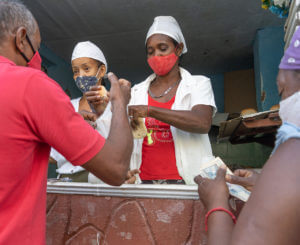 The next day I headed out shortly after sunrise to investigate the more established part of town. En route, I passed a bakery with a short queue and one of the bakers, a spirited middle-aged woman, saw me stop to take photos. She and her co-worker then proceeded to chat me up and posed for a number of photos. She also explained the coupon/rationing system. Bread was selling for one peso but only for those with the daily ration book. They asked me for a pen but all I had to give them was a thick permanent marker and some pieces of gum, for which the baker thanked me. I made a mental note to bring lots of pens on my next trip to Cuba or such places.
The next day I headed out shortly after sunrise to investigate the more established part of town. En route, I passed a bakery with a short queue and one of the bakers, a spirited middle-aged woman, saw me stop to take photos. She and her co-worker then proceeded to chat me up and posed for a number of photos. She also explained the coupon/rationing system. Bread was selling for one peso but only for those with the daily ration book. They asked me for a pen but all I had to give them was a thick permanent marker and some pieces of gum, for which the baker thanked me. I made a mental note to bring lots of pens on my next trip to Cuba or such places.
Proceeding onward, I saw the great potential of the town as a tourist attraction. There were at least three well-maintained town squares and many restaurants and shops. Vendors had set up their trinkets on various side streets, and I was sad to see that I was the only shopper. On another street I bought a couple of shirts for my two daughters, and engaged in a lengthy conversation with the kiosk owner, Marta [identity protected]. She said that she was about to start a new job as a tour guide and had completed the first year of university studies. While her young daughter lounged nearby, she allowed me to videotape the exchange, a rambling discussion that touched upon the violent history of the area to the future of the nation in the face of so many challenges.
“Do you think there is future for Cuba?” I began.
“Really, things are not going well because the Communist system doesn’t function,” she observed. “And it doesn’t work because it’s so centralized. “At the root of the [economic] problem is that there is just not enough support for towns that don’t have a tourist industry.” She provided some concrete examples of weak infrastructure that needed serious attention, such as a provincial water dam and the local city streets.
I asked her, “Do you think the foundation of such problems is bureaucracy or the failures of leaders.
“Both of these. We’re similar the former Soviet Union. It’s a little of ignorance and excesses of bureaucracy…and there’s also a problem of storage and stocking of materials.”
As she started making such pointed comments about the Cuban government, I was startled, and asked her for guidance.
“Do you have any concerns about speaking so frankly?” I explained that I planned on including such interviews on my blog and on YouTube.
“Well, I only worry about my job and my partner, not the government” I told her I would obscure her face and identity.
“We need more freedom,” she later said, and provided instances of where the local government meddled in small businesses.
Finally, I asked for her thoughts on the demonstrations in Havana and some other Cuban cities in July of this year. She said she was “against any vandalism”. But I hadn’t yet researched about any such activity. When I pressed her whether the vast majority of the protesters were peaceful and that any violence reported by the government must have been isolated, she concurred. She also said she knew that there were many of the demonstrators who were still in jail, simply for expressing their concerns. She said that anyone who showed up to subsequent demonstrations and wore white clothes or even white arm bands were quickly picked up by the Cuban police, since the color was now associated with the long term “Mothers in White” protests. At the end of our 12-minute interview, she returned to her complaint, “The centralized economy and communism do not work.”
I subsequently reviewed many videos of the July 11 demonstrations and in these I watched scenes of thousands of Cubans demonstrating in the streets, and the violent response to them by Cuban police – uniformed and plain-clothed. I also interviewed some Cuban witnesses who were in the Havana neighborhoods where much of the protesting took place. Some of the demonstrators resisted arrest, and, apparently – and common in such situations around the world – some youth threw stones at the police or opportunistically broke into stores to loot. To me, it’s not hard to imagine that some demonstrators would take out their anger at the heavy-handed police response on some nearby police vehicles. But many Cubans were arrested just for being at the wrong place at the wrong time, gawking from a street corner. They would spend days or weeks languishing in prison, until they could find a lawyer to submit promissory documents that they would never again attend any demonstration; some fled to Europe thereafter. There was to be another series of demonstrations in November, 2021, but apparently one of the prominent leaders, one Junior García, called it off from his exile in Spain. When I interviewed two Cuban women about the demonstrations, I asked them to consider what will happen, should the economy continue to deteriorate. I said, “How much longer can the people here put up with such misery?” One offered, “Well it will be like the [French] Revolution; or what happened in the U.S.S.R.”
Reading the comments on YouTube accompanying a TeleMundo documentary of the July 11 demonstrations, I came across one interesting armchair analysis, placed in both English and Spanish:
“…you have hundreds of thousands of brothers and sisters living in America who want you to raise your living standards as they have been able to do in the US. in order to do that you must petition your government to make changes to allow this to happen. enough is enough. it’s time for Cuba to rise up. there is no need for a violent revolution it’s [sic] simply requires the people to say “no more”. you are allowing China to interfere with what you were doing to try to make things better for your country and your people. they are teaching your government how to control the Internet which is an Intercal [sic] part of Chinese communism control of the people. you don’t need this Cuba.”
While waiting in line to buy another wi-fi card, I met a vibrant and intrepid young German woman, Katarina, who, like me, was exploring Cuba alone and was in her second of three weeks in country. We apparently had a lot in common: she was a vegetarian, loved traveling, and this trip was for her to recharge her energy before she started a new job. I showed her to a nearby hotel restaurant, where we both enjoyed a carbonated orange soda refresco, looked at my map, and compared notes. We agreed to meet again later that day around 5:00 p.m. so I could share with her some of my Cuba photos from my laptop computer.
Katie, as she liked to be called, described to me some ordeals she had gone through while in Cuba and to get to Trinidad; the source of many of her woes was her inability to speak Spanish. We concurred on how friendly the Cubans were. A fruitless search for an Italian restaurant ultimately resulted in us stumbling across a wonderful “gourmet” restaurant, where enjoyed a vegan dinner together, then walked to a town plaza to listen in the cool night air to a 9-piece musical group play energetic contemporary Cuban raggaeton music. Katie and I agreed to keep in touch after she traveled on to Cuba’s northern beaches and I went West to the southern side the next day. I have the urge to explore the coast and waterways before I return to Havana on the 15th to prepare to document the nearby San Lazaro religious festival.
-
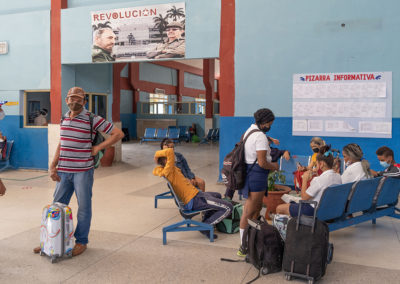
My wait at this bus station in Sancti Spiritus was for naught
-
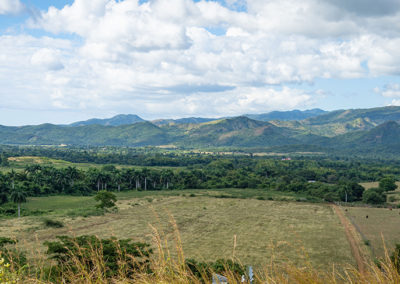
Scenery en route from Sancti Spiritus to Trinidad was lovely.
-

Promotional billboard at entrance to Trinidad
-
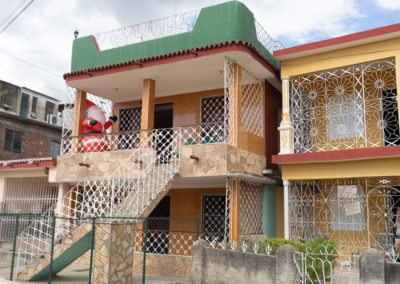
Evidence of consumer Christmas experience were rare.
-

Block apartment buildings on the non-tourist side of Trinidad.
-

Slogans of encouragement abound throughout Cuba
-
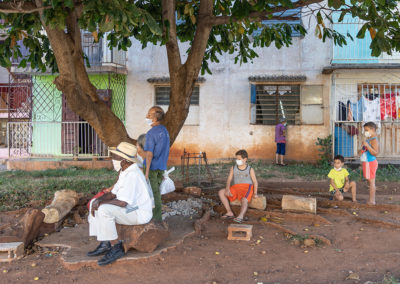
Trinidad daily life.
-

Block apartment buildings
-
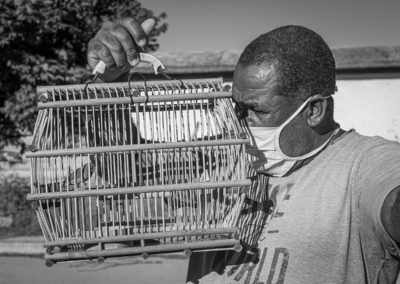
A man who traps and sells small birds peers into the cage of a hapless animal.
-

Private sales on the streets of Trinidad.
-
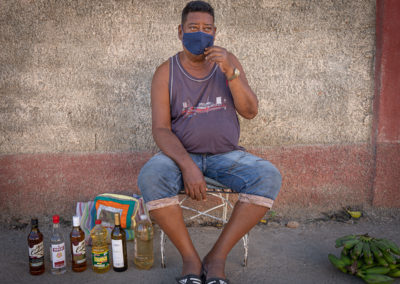
Private sales on the streets of Trinidad.
-
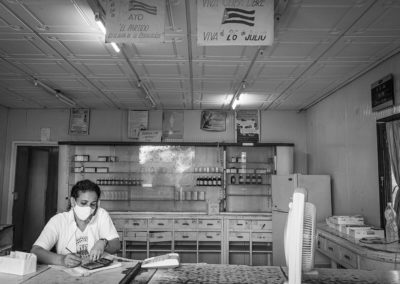
Interior of a Trinidad pharmacy.
-

Three young men in front of their block apartment building.
-

Work horse enjoys a free day.
-
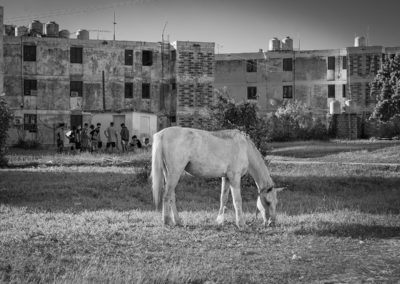
Work horse enjoys a free day.
-
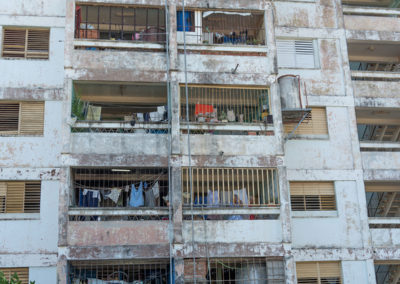
Block apartment buildings on the non-tourist side of Trinidad.
-

Young boys play marble in the streets of Trinidad, Cuba.
-
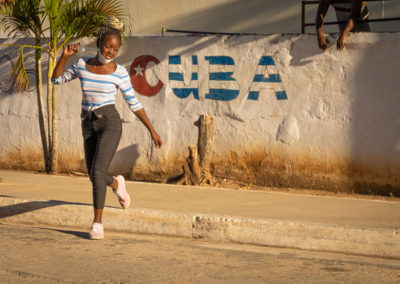
Young girl in the streets of Trinidad, Cuba.
-

Youth in front of a Trinidad apartment demonstrate bonds of friendship
-

Residents congregate in front of their apartment building in Trinidad, Cuba.
-

Small waiting line in front of a Trinidad store.
-
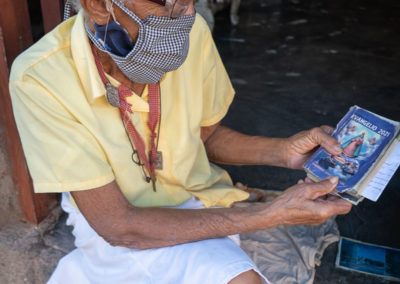
81-year old Trinidad resident Elena Solís shares stories from her youthful involvement in the Cuban revolution.
-
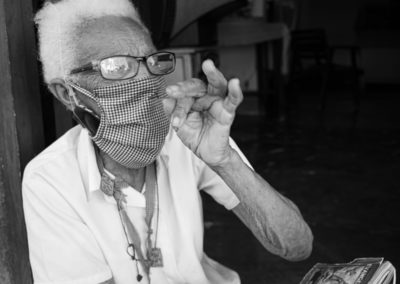
81-year old Trinidad resident Elena Solís shares stories from her youthful involvement in the Cuban revolution.
-
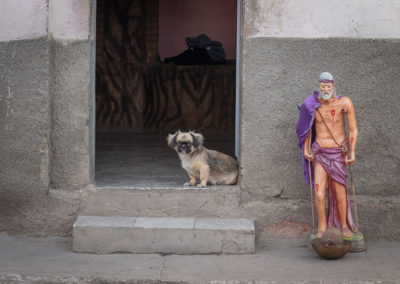
Trinidad house with religious icon prepared for a local festival honoring Saint Lorenzo.
-
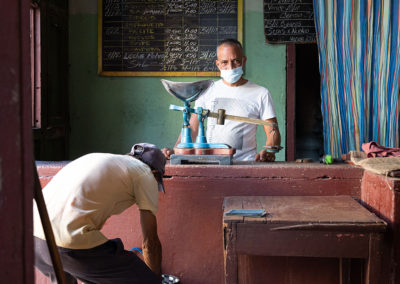
Bodega in Trinidad.
-
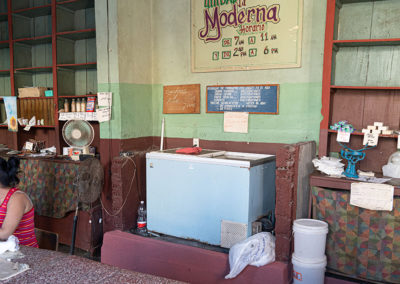
Bodega in Trinidad.
-
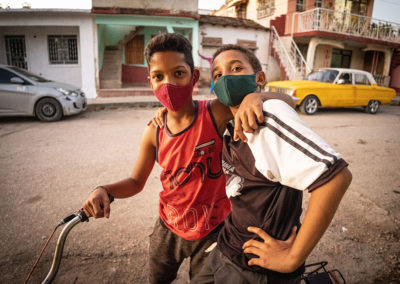
Two young friends in Trinidad.
-

Large dog in a small house had my sympathies.
-

A typical ration book, known to all Cubans as "la libreta".
-
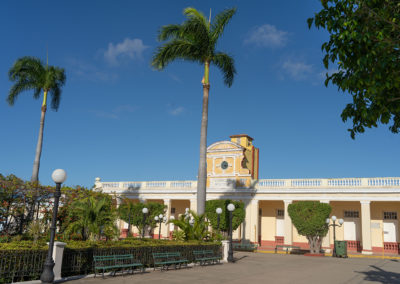
Tourist area of Trinidad.
-

Tourist area of Trinidad.
-

Tourist area of Trinidad.
-

Tourist area of Trinidad.
-
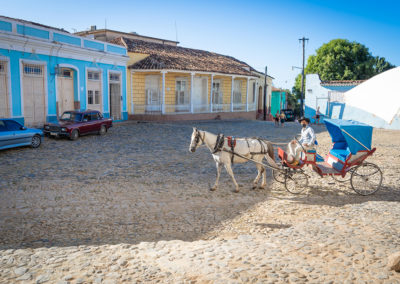
Tourist area of Trinidad.
-

Tourist area of Trinidad.
-
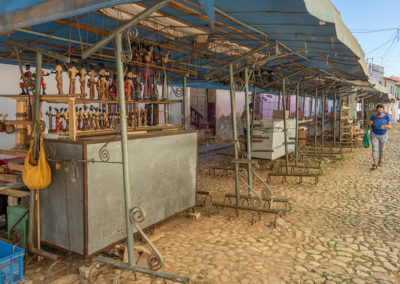
Stalls had plenty of tchotchkes for sale – but no customers!
-

Looking outside from inside a Trinidad house.
-
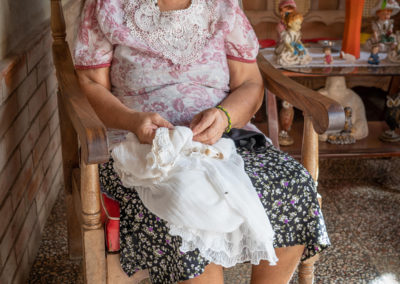
A woman pauses in her sewing labors in Trinidad, Cuba (December, 2021)
-
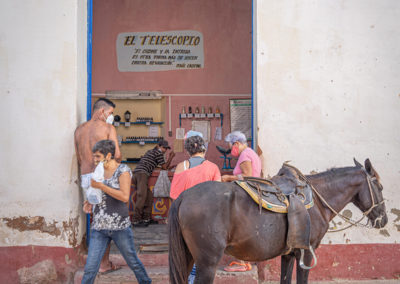
In front of a Trinidad bodega.
-
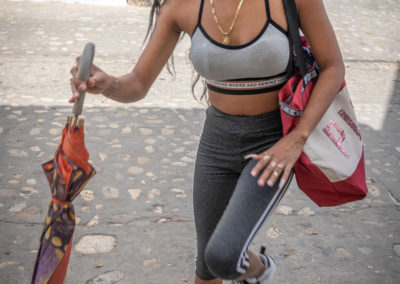
A young woman from Trinidad en route to buy phone credits.
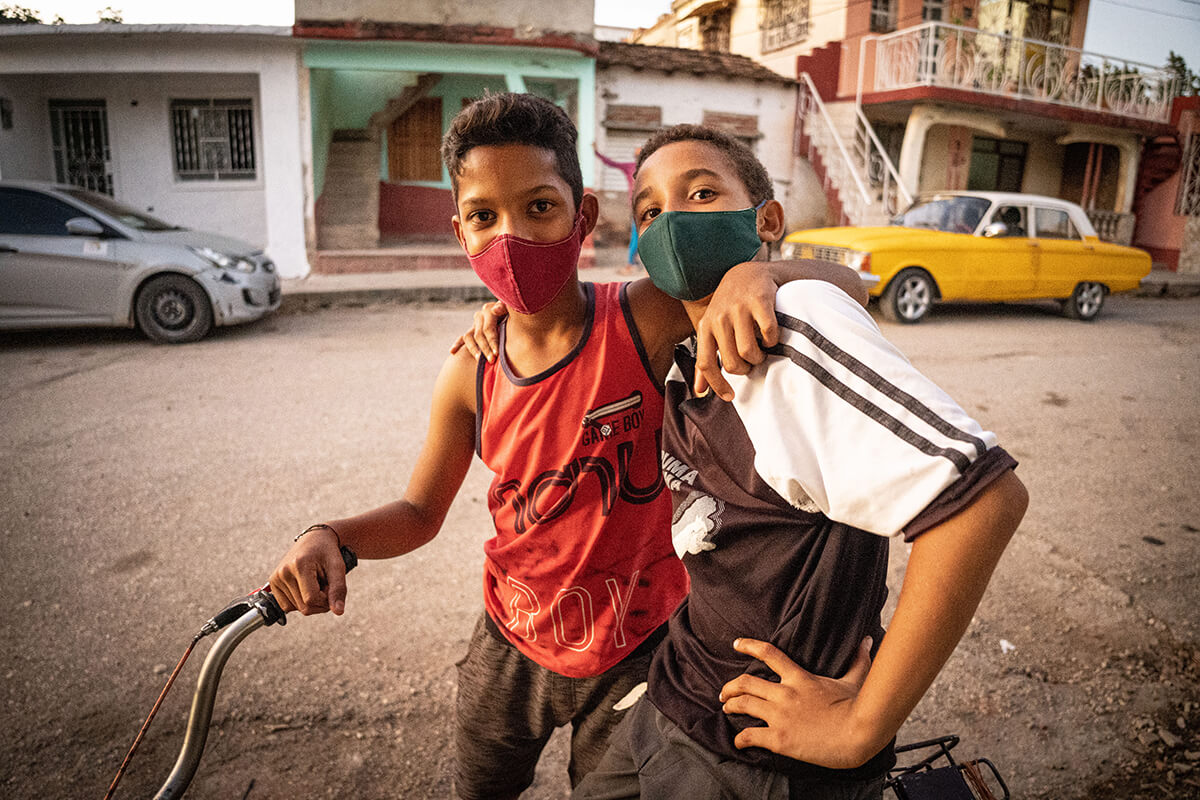
0 Comments